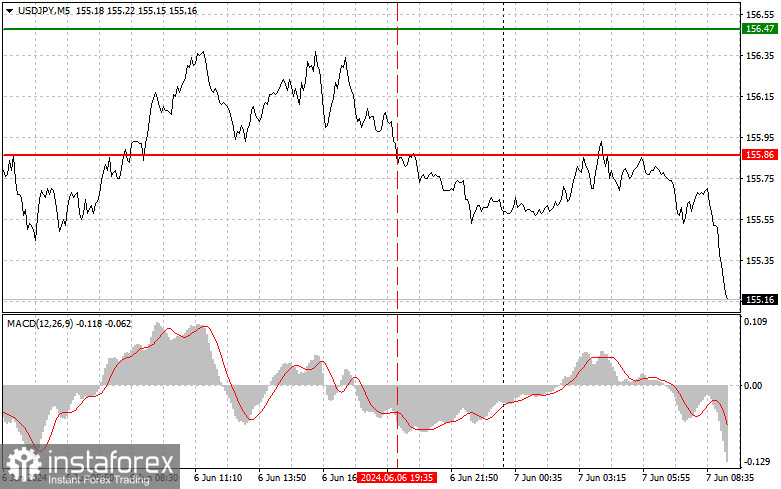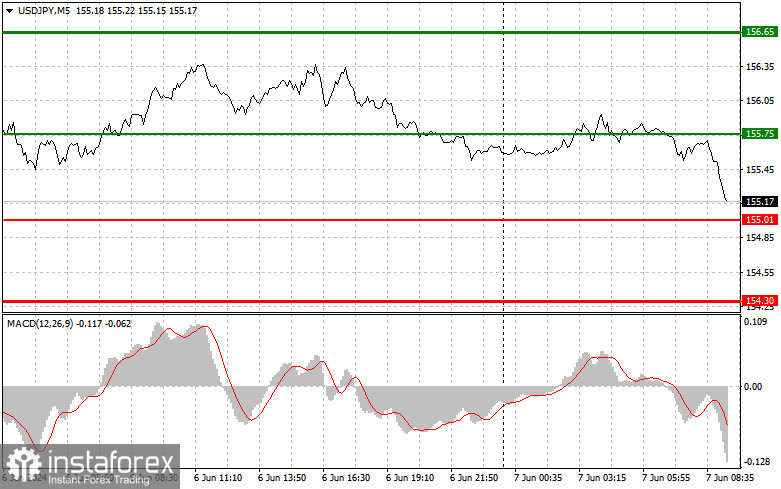Analysis of transactions and tips on trading the Japanese yen
The price test of 155.86 came at a time when the MACD indicator went down a lot from zero, which limited the pair's downward potential at the end of the day. For this reason, I did not sell the dollar. Today, during Asian trading, the pair continued to fall. It can hardly be attributed to the rather contradictory statistics on changes in the volume of household spending in Japan and the index of leading economic indicators, so it looks more like positioning in front of important data expected today on the US labor market. But we will talk about this in more detail in the forecast for the afternoon. For the time being, I will look for suitable entry points for scenario No. 2 to buy, counting on a market reversal and a return of demand for a fairly cheap American dollar. As for the intraday strategy, I will rely more on the implementation of scenario No. 2.

Buy signal
Scenario No. 1: I plan to buy USD/JPY today when I reach the entry point in the area of 155.75 (green line on the chart) in order to grow to the level of 155.65 (thicker green line on the chart). In the area of 156.65, I'm going to exit purchases and open sales in the opposite direction (counting on a movement of 30-35 points in the opposite direction from the level). The pair's growth can be counted on today after strong US data. Important! Before buying, make sure that the MACD indicator is above the zero mark and is just starting to grow from it.
Scenario No. 2: I also plan to buy USD/JPY today in the case of two consecutive price tests of 155.01 at a time when the MACD indicator will be in the oversold area. This will limit the pair's downward potential and lead to a reverse upward reversal of the market. We can expect an increase to the opposite levels of 155.75 and 156.65.
Sell signal
Scenario No. 1: I plan to sell USD/JPY today only after updating the level of 155.01 (the red line on the chart), which will lead to a rapid decline in the pair. The key target of sellers will be the 154.30 level, where I'm going to exit sales, as well as immediately open purchases in the opposite direction (counting on a movement of 20-25 points in the opposite direction from the level). The pressure on the pair may return in case of an unsuccessful consolidation in the area of the daily maximum. Important! Before selling, make sure that the MACD indicator is below the zero mark and is just beginning its decline from it.
Scenario No. 2: I also plan to sell USD/JPY today in the case of two consecutive price tests of 155.75 at a time when the MACD indicator will be in the overbought area. This will limit the upward potential of the pair and lead to a reverse downward reversal of the market. We can expect a decline to the opposite levels of 155.01 and 154.30.
Chart Key:
Thin green line: Entry price for buying the trading instrument.
Thick green line: Expected price where you can place Take Profit or manually secure profits, as further growth above this level is unlikely.
Thin red line: Entry price for selling the trading instrument.
Thick red line: Expected price where you can place Take Profit or manually secure profits, as further decline below this level is unlikely.
MACD indicator: When entering the market, it is important to be guided by overbought and oversold zones.
Important: Beginner traders in the forex market should be very cautious when making decisions to enter the market. It is best to stay out of the market before the release of important fundamental reports to avoid sudden exchange rate fluctuations. If you decide to trade during news releases, always set stop orders to minimize losses. Without stop orders, you can quickly lose your entire deposit, especially if you do not use money management and trade in large volumes.
Remember, successful trading requires a clear trading plan, like the one presented above. Making spontaneous trading decisions based on the current market situation is inherently a losing strategy for an intraday trader.
 English
English 
 Русский
Русский Bahasa Indonesia
Bahasa Indonesia Bahasa Malay
Bahasa Malay ไทย
ไทย Español
Español Deutsch
Deutsch Български
Български Français
Français Tiếng Việt
Tiếng Việt 中文
中文 বাংলা
বাংলা हिन्दी
हिन्दी Čeština
Čeština Українська
Українська Română
Română

